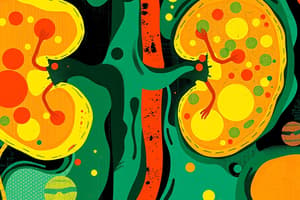Podcast
Questions and Answers
What is the primary benefit of bladder catheterization in urine output measurement?
What is the primary benefit of bladder catheterization in urine output measurement?
- It is non-invasive and requires no specialized training.
- It only requires collection over a 24-hour period.
- It allows for estimation of post-void residual volume.
- It provides continuous and accurate measurement of urine output. (correct)
Which method is suitable for patients who void normally?
Which method is suitable for patients who void normally?
- Urinary Collection Bags
- 24-Hour Urine Collection
- Graduated Containers (correct)
- Bladder Scanner
Why is it essential to document factors like fluid intake during urine measurement?
Why is it essential to document factors like fluid intake during urine measurement?
- To identify potential inaccuracies in total urine output. (correct)
- To ensure bladder catheterization is performed correctly.
- To avoid the need for non-invasive measurement techniques.
- To facilitate the calculation of urine output rate.
What does the urine output rate indicate?
What does the urine output rate indicate?
What is a key consideration for ensuring accuracy in timed urine collections?
What is a key consideration for ensuring accuracy in timed urine collections?
What is the first step in measuring urine output accurately?
What is the first step in measuring urine output accurately?
After collecting urine, how is the volume specifically measured?
After collecting urine, how is the volume specifically measured?
Which of the following is NOT a step in urine output measurement?
Which of the following is NOT a step in urine output measurement?
What unit is typically used for measuring urine output?
What unit is typically used for measuring urine output?
Which best describes the method of urine output measurement?
Which best describes the method of urine output measurement?
Study Notes
Measuring Urine Output: Measurement Techniques
-
Direct Measurement
- Bladder Catheterization
- Involves placing a catheter in the bladder.
- Allows for continuous and accurate measurement of urine output.
- Ideal for critically ill patients or those requiring close monitoring.
- Bladder Catheterization
-
Collection Containers
-
Urinary Collection Bags
- Used for patients with urinary catheters.
- Simple to measure total output by reading graduations on the bag.
-
Graduated Containers
- For patients who void normally; urine is collected in a graduated container.
- Allows for precise volume measurement.
-
-
Timed Urine Collections
- 24-Hour Urine Collection
- Measures total urine output over 24 hours.
- Requires collecting all urine produced during the period for accurate assessment.
- 24-Hour Urine Collection
-
Non-invasive Measurement
- Bladder Scanner
- Uses ultrasound technology to measure post-void residual volume.
- Can help estimate urine volume in patients unable to void completely.
- Bladder Scanner
-
Calculation Methods
- Urine Output Rate
- Calculated as mL per hour.
- Important for assessing renal function and fluid balance.
- Urine Output Rate
-
Considerations for Accuracy
- Ensure all urine is collected in the required time frame (especially in timed collections).
- Document any factors that may affect results, such as fluid intake or diuretics.
- Regularly calibrate measurement devices to maintain accuracy.
Direct Measurement Techniques
- Bladder Catheterization: Insertion of a catheter into the bladder for continuous, precise urine output measurement; essential for critically ill patients requiring monitoring.
- Urinary Collection Bags: Employed with urinary catheters; allows easy total urine output measurement by reading bag graduations.
- Graduated Containers: Utilized for normal voiding patients, providing precise urine volume measurements.
Timed Urine Collections
- 24-Hour Urine Collection: Gathers all urine produced in a 24-hour period, ensuring accurate total output assessment.
Non-invasive Measurement
- Bladder Scanner: Employs ultrasound technology to determine post-void residual volume, aiding in estimating urine volume for patients unable to void completely.
Calculation Methods
- Urine Output Rate: Expressed in mL per hour; crucial for evaluating renal function and maintaining fluid balance.
Considerations for Accuracy
- Emphasize the importance of complete urine collection within the stipulated time for timed collections.
- Document any influencing factors like fluid intake or diuretics that may skew results.
- Regular calibration of measurement devices is necessary to uphold accuracy in urine output assessment.
Measurement Techniques for Urine Output
- Direct Measurement Methods focus on directly collecting and assessing urine.
- Bladder Catheterization allows continuous and accurate urine output monitoring, essential for critically ill patients or those needing close observation.
- Urinary Collection Bags are utilized with catheters, facilitating easy measurement by reading scales on the bag.
- Graduated Containers enable precise volume measurement for patients who void normally, providing accurate output readings.
- 24-Hour Urine Collection aggregates total urine output in a full day, requiring collection of all urine to ensure an accurate assessment.
Non-invasive Measurement Techniques
- Bladder Scanners employ ultrasound technology to assess post-void residual volume, useful for patients who cannot completely void.
Calculation Methods
- Urine Output Rate is a key measure and expressed in mL per hour, crucial for evaluating renal function and fluid balance.
Considerations for Accurate Measurement
- Timely collection of all urine is vital, particularly during timed collection periods.
- Documenting influencing factors like fluid intake and diuretic use is important for interpreting results accurately.
- Regular calibration of measurement devices ensures ongoing accuracy in urine output assessment.
Studying That Suits You
Use AI to generate personalized quizzes and flashcards to suit your learning preferences.
Description
This quiz covers various techniques for measuring urine output, including direct measurement through bladder catheterization and the use of urinary collection bags. It is essential for medical practitioners and caregivers to understand these methods to ensure accurate monitoring of patients' urinary function.




